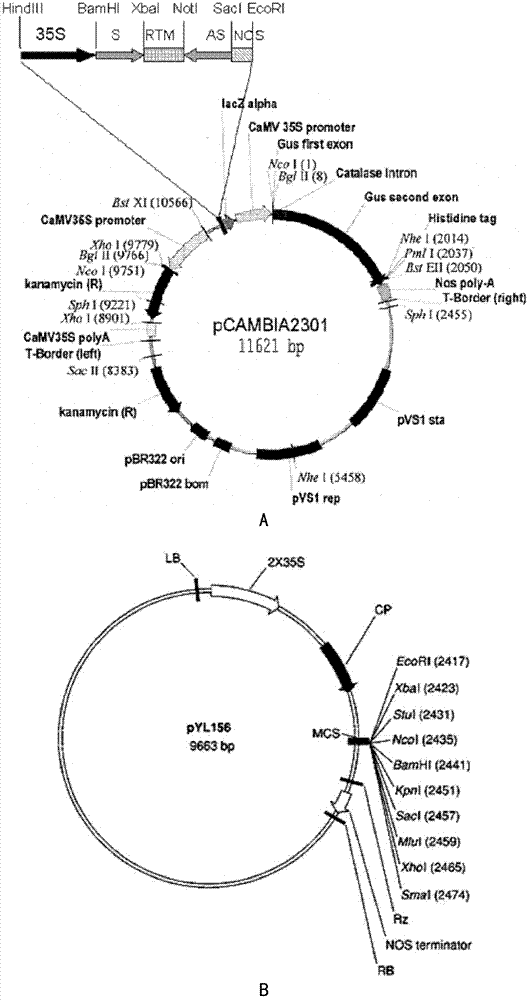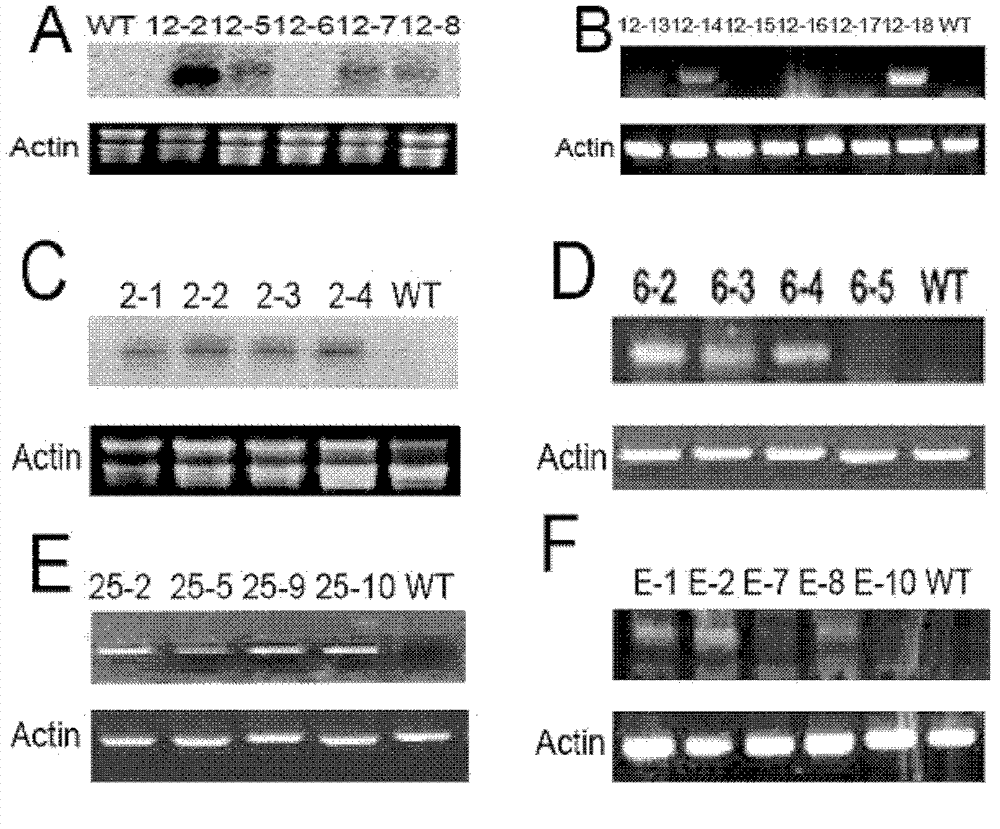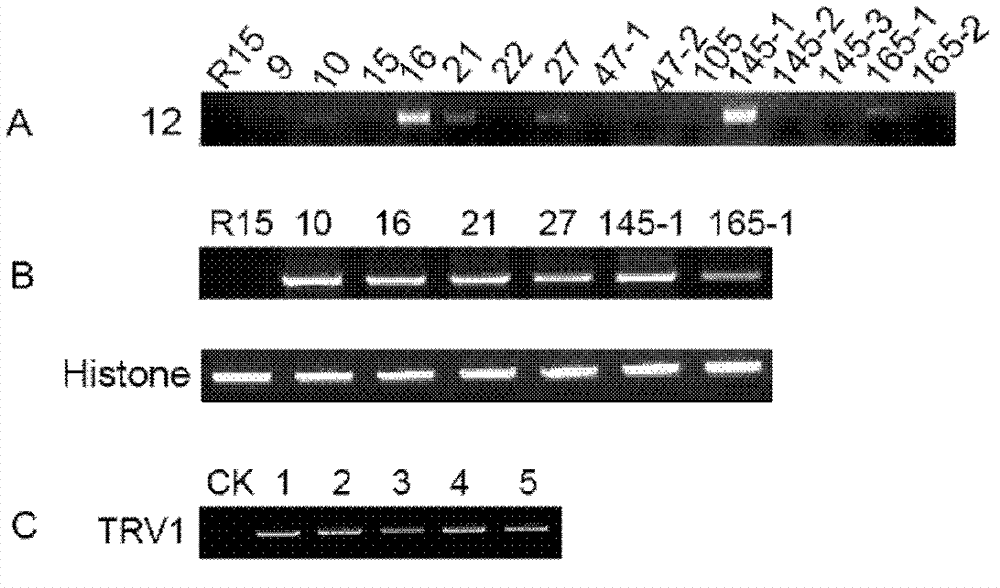Method for raising insect resistance of plants
A technology of plant and ability, applied in the fields of plant bioengineering and plant improvement genetic engineering, which can solve the problems of the decline of insect resistance of transgenic insect-resistant plants and the proliferation of other pests
- Summary
- Abstract
- Description
- Claims
- Application Information
AI Technical Summary
Problems solved by technology
Method used
Image
Examples
Embodiment 1
[0167] Embodiment 1, be used to construct the sequence fragment of dsRNA carrier
[0168] With Asian cotton bollworm (Helicovepa armigera) cDNA library (ZAP express) (contain 1mgg -1 The total RNA of the midgut of the fifth instar cotton bollworm after one day of artificial diet with the concentration of gossypol was used as a material to construct a cDNA library) as a template, and 29 EST fragments for constructing dsRNA expression vectors were amplified, called WXM-1~WXM-29 . The genes related to EST fragments are shown in Table 2.
[0169] Table 2
[0170]
[0171] In the present invention, coding sequences of trypsin, dopa decarboxylase, NADH dehydrogenase flavoprotein 2, ATP synthase β subunit, myosin heavy chain subtype B, and RTM intron sequences are used. Among them, the darkened part in gray is the fragment used to construct the dsRNA vector.
[0172] SEQ ID NO: 1 (WXM-2, trypsin precursor coding sequence, GenBank: EE399600.1):
[0173] ACCCTACTATTGCGGCTCTTT...
Embodiment 2
[0201] Embodiment 2, separation of gene fragments such as trypsin, dopa decarboxylase
[0202] With Asian cotton bollworm (Helicovepa armigera) cDNA library (ZAP express) (contain 1mgg -1 The total RNA of the midgut of the fifth instar cotton bollworm after one day of artificial diet with the concentration of gossypol was used as a material to construct a cDNA library), and PCR amplification was performed to obtain EST fragments for constructing dsRNA expression vectors respectively. The reaction solution is: 5 μL 10× buffer, 2.5 μL 10mMdNTP, 2 μL primer F, 2 μL primer R, 2 μL cDNA, 1 μL pfu enzyme, add water to make up to 50 μL. The PCR reaction conditions were 94°C for 4min, 30 cycles at 94°C for 30s, 55°C for 30s, 72°C for 2min, and 72°C for 10min. DNA fragments of expected size were recovered after PCR product electrophoresis.
[0203] Using cotton bollworm wxm-12 (NADH dehydrogenase ubiquinone flavoprotein 2) as a template, the cDNA sequence of the corresponding gene of...
Embodiment 3
[0236] Embodiment 3, vector construction and Agrobacterium transformation
[0237] 1. Vector Construction
[0238] The structure of the dsRNA vector to be constructed is as follows: figure 1 Shown in A, including the plant expression promoter CaMV35S promoter, a forward (i.e. Sense, S) gene fragment, an internal element of the Arabidopsis RTM gene (i.e. Intron, about 128bp, and a reverse gene fragment (namely Antisense, AS) and NOS terminator. It is obtained by inserting the sequence containing Sense-Intron-Antisense into the BamHI and SacI sites on the pCambia2301 vector (purchased from Cambia Company).
[0239] Using the Arabidopsis genome as a template, first use the internal element (about 128bp) of the Arabidopsis RTM gene (AT2G43730) with the specific primer RTM+(5'-TCTAGAACGTTGTAAGTCTATTTTTG-3'(SEQ ID NO: 27)) containing XbaI and NotI and RTM-(5'-GCGGCCGCTCTGCTGGGTCCAAATCACA-3'(SEQ IDNO:28)) were amplified by high-fidelity enzyme pfu, the PCR product was double-digest...
PUM
| Property | Measurement | Unit |
|---|---|---|
| wavelength | aaaaa | aaaaa |
Abstract
Description
Claims
Application Information
 Login to View More
Login to View More - R&D
- Intellectual Property
- Life Sciences
- Materials
- Tech Scout
- Unparalleled Data Quality
- Higher Quality Content
- 60% Fewer Hallucinations
Browse by: Latest US Patents, China's latest patents, Technical Efficacy Thesaurus, Application Domain, Technology Topic, Popular Technical Reports.
© 2025 PatSnap. All rights reserved.Legal|Privacy policy|Modern Slavery Act Transparency Statement|Sitemap|About US| Contact US: help@patsnap.com



